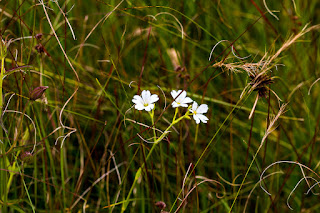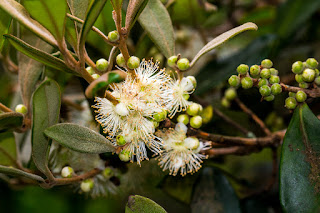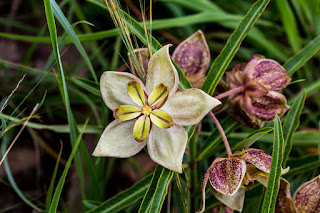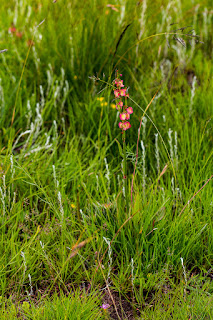With rain forecast after midday, we decided to walk the clifftops at Smedmore where we would always be reasonably close to the vehicles. We checked to see if the usual crop of Riocreuxia torulosa was flowering but instead there was Cryptolepis capensis with its long white twisted petals. We walked on to see that most of the colony of Pachycarpus coronarius had already set fruit. Growing in a small cluster of shrubs we found Dioscorea quartiniana flowering - previously we had thought this plant was a D. multiloba although we had never seen it in flower. Not far away we found another common Dioscorea species, D. cotinifolia.
 |
| Cryptolepis capensis |
 |
| Dioscorea quartiniana |
 |
| Dioscorea cotinifolia |
The adjacent grassland hosted
Eucomis autumnalis, Indigastrum fastigiatum and a few
Pachycapus coronarius that were still flowering. At the forest edge we found a
Solanum giganteum. Scrambling down the steep slope below the rocky edge we came across a large colony of
Streptocarpus formosus -- rather difficult to get a decent photograph without holding onto nearby trees with your teeth.
 |
| Eucomis autumnalis |
 |
| Indigastrum fastigiatum |
 |
| Pachycarpus coronarius |
 |
| Solanum giganteum |
 |
| Streptocarpus formosus |
Clambering back out of the forest we found the first of many
Eugenia erythrophyllla trees in flower. As this was the first time many of us had seen such prolific flowering from these
Eugenias, we surmised that they flower only infrequently. Near to the first of these was a small
Homalium rufescens and a bit further along we found several
Schrebera alata bearing their pink and white sweet-smelling flowers.
 |
| Eugenia erythrophylla |
 |
| Homalium rufescens |
 |
| Schrebera alata |
Again venturing down the slope, Anne found a single flower on
Mimusops obovata. A nearby
Garcinia gerrardii was bearing some immature fruits and nestled between large rocks were two
Aspalathus dahlgrenii. Tracy found two climbing plants emerging from gaps between some rocks --
Pilogyne scabra and
Coccinia mackenii.
 |
| Mimusops obovata |
 |
| Garcinia gerrardii |
 |
| Aspalathus dahlgrenii |
 |
| Pilogyne scabra |
 |
| Coccinia mackenii |
Back at the cliff edge we found
Osyridicarpos schimperianus in flower and Dorothy collected a specimen of
Oncinotis tenuiloba. Back out in the grassland there were
Dimorphotheca fruticosa and after persuading a bud to open, we found an undescribed
Pachycarpus - something that might be a hybrid with
P. coronarius.
 |
| Osyridicarpos schimperianus |
 |
| Oncinotis tenuiloba |
 |
| Dimorphotheca fruticosa |
 |
| Pachycarpus sp. nov. |
Next we found several
Pavetta lanceolata shrubs poking their flowering tops out above the other trees. As we entered the edge of the forest we spotted
Dalechampia capensis and once we had pushed our way through the undergrowth, we could see several
Calodendrum capense proudly displaying their flowers as patches of pink in the otherwise green forest.
 |
| Pavtta lanceolata |
 |
| Dalechampia capensis |
 |
| Calodendrum capense |
Turning the corner we found a single flower of
Hyperacanthus amoenus.
 |
| Hyperacanthus amoenus |
After a brief stop for lunch on some ant-free rocks (at this time of the year it is difficult to find a place to sit without getting attacked by pugnacious ants) we headed back before the promised rain. As we entered the Beacon Hill gate of the reserve we saw several
Habenaria dives.
 |
| Habenaria dives |
Participants: Alf H, Anne S, Dorothy M, Gail B-W, Graham G, Kate G, Mark G, Maggie A, Tracy T.








































































































